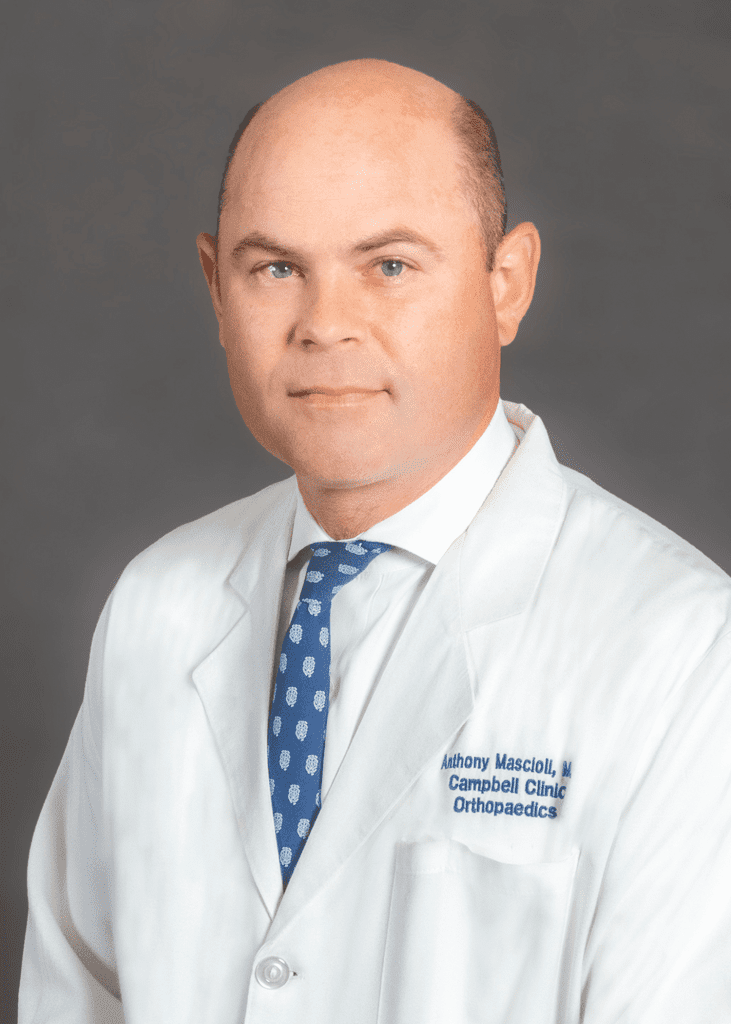Anthony A. Mascioli, M.D.
Education
State University of New York at Albany, 1998
Med School: SUNY-Downstate College of Medicine, 2003
Residency: UT-Campbell Clinic, 2008
Sports Medicine Coverage


Other Information
Board of Certification: American Board of Orthopaedic Surgery
Shoulder Cuff Tear and Repair
If you have a rotator cuff tear and you keep using it despite increasing pain, you may cause further damage. A rotator cuff tear can get larger over time. Chronic shoulder and arm pain are good reasons to see your doctor. Early treatment can prevent your symptoms from getting worse. It will also get you back to your normal routine that much quicker. The goal of any treatment is to reduce pain and restore function. There are several treatment options for a rotator cuff tear, and the best option is different for every person. In planning your treatment, I will consider your age, activity level, general health, and the type of tear you have.
If surgery is your best option, it will most often involve re-attaching the tendon to the head of humerus (upper arm bone). A partial tear, however, may need only a trimming or smoothing procedure called a debridement. A complete tear is repaired by stitching the tendon back to its original site on the humerus. There are 3 techniques available, depending on the type of tear a patient has. An open repair, arthroscopic repair, or a mini-open repair.
A traditional open surgical incision (several centimeters long) is often required if the tear is large or complex. The incision is made over the shoulder and detaches one of the shoulder muscles (deltoid) to better see and gain access to the torn tendon. During an open repair, bone spurs are typically removed from the underside of the acromion (this procedure is called an acromioplasty). An open repair may be a good option if the tear is large or complex or if additional reconstruction, such as a tendon transfer, is indicated.
During an all-arthroscopy, a small camera is inserted, called an arthroscope, into the shoulder joint. The camera displays pictures on a television screen, and your surgeon uses these images to guide miniature surgical instruments. Because the arthroscope and surgical instruments are thin, your surgeon can use very small incisions (cuts), rather than the larger incision needed for standard, open surgery. All-arthroscopic repair is usually an outpatient procedure and is the least invasive method to repair a torn rotator cuff. The patient goes home the same day and recovers in the comfort of their own home.
The mini-open repair uses newer technology and instruments to perform a repair through a small incision. The incision is typically 3 to 5 cm long. This technique uses arthroscopy to assess and treat damage to other structures within the joint. Bone spurs, for example, are often removed arthroscopically as well. This avoids the need to detach the deltoid muscle. Once the arthroscopic portion of the procedure is completed, the rotator cuff is repaired through the same mini-open incision. During the tendon repair, the surgeon views the shoulder structures directly, rather than through the video monitor.
Partial Knee Replacement
Dr. Mascioli is an orthopaedic surgeon performing partial knee replacement in Campbell Clinic’s outpatient Surgery Center. Partial knee replacement utilizes a minimally invasive approach (employing a smaller incision and less disruption) when compared to traditional total knee replacements.
For appointments call
901-759-3111

